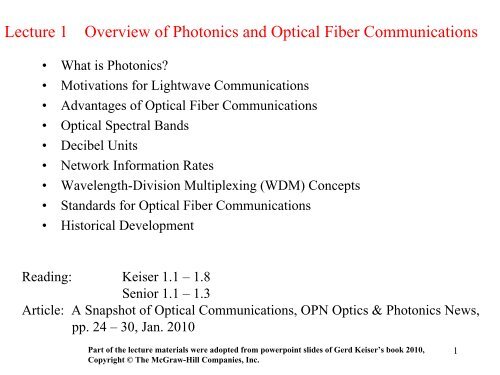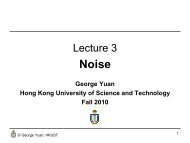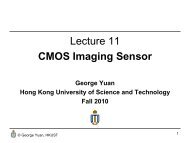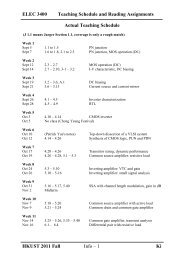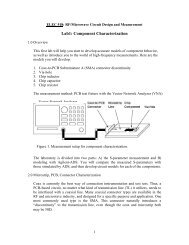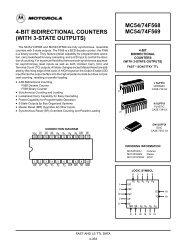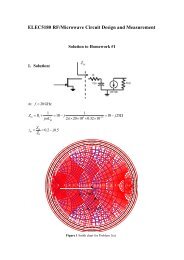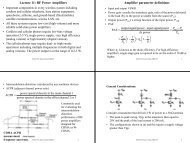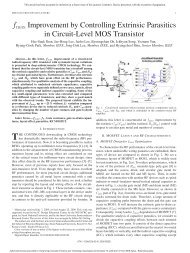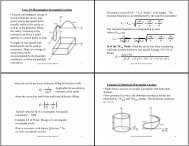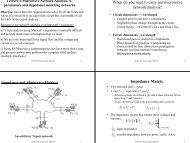Lecture 1 Overview of Photonics and Optical Fiber Communications
Lecture 1 Overview of Photonics and Optical Fiber Communications
Lecture 1 Overview of Photonics and Optical Fiber Communications
Create successful ePaper yourself
Turn your PDF publications into a flip-book with our unique Google optimized e-Paper software.
<strong>Lecture</strong> 1 <strong>Overview</strong> <strong>of</strong> <strong>Photonics</strong> <strong>and</strong> <strong>Optical</strong> <strong>Fiber</strong> <strong>Communications</strong><br />
• What is <strong>Photonics</strong>?<br />
• Motivations for Lightwave <strong>Communications</strong><br />
• Advantages <strong>of</strong> <strong>Optical</strong> <strong>Fiber</strong> <strong>Communications</strong><br />
• <strong>Optical</strong> Spectral B<strong>and</strong>s<br />
• Decibel Units<br />
• Network Information Rates<br />
• Wavelength-Division Multiplexing (WDM) Concepts<br />
• St<strong>and</strong>ards for <strong>Optical</strong> <strong>Fiber</strong> <strong>Communications</strong><br />
• Historical Development<br />
Reading: Keiser 1.1 – 1.8<br />
Senior 1.1 – 1.3<br />
Article: A Snapshot <strong>of</strong> <strong>Optical</strong> <strong>Communications</strong>, OPN Optics & <strong>Photonics</strong> News,<br />
pp. 24 – 30, Jan. 2010<br />
Part <strong>of</strong> the lecture materials were adopted from powerpoint slides <strong>of</strong> Gerd Keiser’s book 2010,<br />
Copyright © The McGraw-Hill Companies, Inc.<br />
1
<strong>Fiber</strong>-optic communications <strong>and</strong> modern society<br />
• The recent award <strong>of</strong> the Nobel Prize in Physics<br />
2009 to Pr<strong>of</strong>. Charles Kao – widely regarded as<br />
the “father <strong>of</strong> fiber-optic communications” –<br />
underscores the tremendous changes that optical<br />
fiber has brought about in modern society.<br />
• <strong>Fiber</strong> optics has revolutionized the way we receive<br />
information <strong>and</strong> communicate with one another,<br />
<strong>and</strong> it has played a major role in ushering in the<br />
Information Age.<br />
Source: OPN, pp. 24- 30 Jan. 2010.<br />
2
Optics <strong>and</strong> <strong>Photonics</strong><br />
• Optics – the science <strong>of</strong> light<br />
(e.g. physical optics, nonlinear optics, quantum optics, nano-optics)<br />
• <strong>Photonics</strong> – the technology using light (“photons”) <strong>and</strong> electrons<br />
(e.g. optical fiber communications, light-emitting diodes, laser diodes,<br />
photodetectors, photovoltaic devices, optical switches,<br />
optical modulators, displays, etc.)<br />
In the past, people used the term “optoelectronics” to differentiate those<br />
technologies using photons <strong>and</strong> electrons (e.g. light-emitting diodes)<br />
from those technologies using only photons (e.g. optical fibers). But this<br />
distinction has been falling out <strong>of</strong> favor in recent years <strong>and</strong> the term<br />
“photonics” become commonly adopted.<br />
3
What is photonics?<br />
<strong>Photonics</strong> is analogous to electronics.<br />
What is electronics?<br />
Electronics is the study <strong>of</strong> the flow <strong>of</strong> charge<br />
(electron) through various materials <strong>and</strong> devices such<br />
as, semiconductors, resistors, inductors, capacitors,<br />
nano-structures, etc.<br />
All applications <strong>of</strong> electronics involve the<br />
transmission <strong>of</strong> power <strong>and</strong> possibly information.<br />
4
What is photonics?<br />
• <strong>Photonics</strong> is the technology <strong>of</strong> generating / controlling /<br />
detecting light <strong>and</strong> other forms <strong>of</strong> radiant energy whose<br />
quantum unit is the photon.<br />
(In physics, a quantum is the minimum unit <strong>of</strong> any physical<br />
entity involved in an interaction. The word comes from the<br />
Latin “quantus” for “how much.”)<br />
• The science includes<br />
– light emission,<br />
– transmission,<br />
– deflection,<br />
– amplification,<br />
– detection<br />
– nonlinear optics<br />
–…<br />
The importance <strong>of</strong> photonics <strong>of</strong>ten<br />
derives from the powerful interplay<br />
between optics <strong>and</strong> electronics!<br />
5
A snapshot <strong>of</strong> photonic technologies<br />
• <strong>Communications</strong> --- fiber-optic communications, optical interconnects,<br />
optical wireless<br />
• Computing --- chip-to-chip optical interconnects, on-chip optical<br />
interconnect communications<br />
• Energy (“Green photonics”) --- solid-state lighting, solar cells<br />
• Human-Machine interface --- CCD/CMOS camera, displays, picoprojectors<br />
• Medicine --- laser surgery, optical coherence tomography (OCT)<br />
• Bio --- optical tweezers, laser-based diagnostics <strong>of</strong> cells/tissues<br />
• Nano --- integrated photonics, sub-diffraction-limited optical microscopy,<br />
optical nanolithography<br />
• Defense --- laser weapons, bio-aerosols monitoring<br />
• Sensing --- fiber sensors, bio-sensing, LIDAR<br />
• Data Storage --- CD/DVD/Blu-ray, holography<br />
• Manufacturing --- laser-based drilling <strong>and</strong> cutting<br />
• Fundamental Science --- femto-/atto-second (10 -15 /10 -18 s) science<br />
• Space Science --- adaptive optics, laser-based interferometers between<br />
satellites<br />
• Entertainment --- laser shows<br />
6<br />
• And many more!!
<strong>Photonics</strong> for communications<br />
• An optical communications system consists <strong>of</strong> many components.<br />
ELEC 4620 will provide an overview <strong>and</strong> the fundamentals <strong>of</strong> some <strong>of</strong><br />
the photonic technologies involved.<br />
Electrical<br />
signal<br />
<strong>Communications</strong><br />
Channel<br />
(Opt. fibers)<br />
<strong>Optical</strong><br />
transmitter<br />
<strong>Optical</strong><br />
receiver<br />
Electrical<br />
signal<br />
electrical<br />
<strong>Optical</strong><br />
electrical<br />
information<br />
information<br />
7
Enabling photonic components for communications<br />
• Laser diodes<br />
• Modulators<br />
• <strong>Optical</strong> fibers<br />
• <strong>Optical</strong> amplifiers<br />
• Wavelength-Division Multiplexing<br />
(WDM) components<br />
• Photodetectors<br />
8
Laser modules in communications<br />
These modern laser modules<br />
incorporate a wavelengthtunable<br />
laser with a<br />
semiconductor optical<br />
amplifier on a III-V<br />
semiconductor compound<br />
indium phosphide (InP) chip.<br />
Ref. Lasers in <strong>Communications</strong>, Patricia Daukantas,<br />
pp. 28-33, March 2010<br />
9
Active <strong>Optical</strong> Cables<br />
Ref. Lasers in <strong>Communications</strong>,<br />
Patricia Daukantas,<br />
pp. 28-33, March 2010<br />
Datacom companies are making networking even easier for<br />
data-center companies by attaching optical transceivers<br />
(transmitters + receivers) permanently to the ends <strong>of</strong> fiber<br />
cables, thus making active optical cables.<br />
10
Various types <strong>of</strong> optical networks<br />
Access networks have garnered new interest because <strong>of</strong> the<br />
growing dem<strong>and</strong> for fiber-to-the-home <strong>and</strong> high-definition<br />
video.<br />
Ref. Lasers in <strong>Communications</strong>, Patricia Daukantas, pp. 28-33, March 2010<br />
11
<strong>Optical</strong> communications for computing<br />
<br />
<strong>Optical</strong> interconnect technology is motivating the development<br />
<strong>of</strong> the R&D field <strong>of</strong> “silicon photonics.”<br />
12
<strong>Optical</strong> interconnects<br />
2002<br />
2007<br />
Electrical interconnects (Copper):<br />
‣ Resistance-capacitance (RC)<br />
delay<br />
‣ Power consumption<br />
‣ B<strong>and</strong>width limitation (~5 GHz)<br />
2017+<br />
2012<br />
<strong>Optical</strong> interconnects<br />
‣ High b<strong>and</strong>width (> 40 Gb/s)<br />
‣ Relatively low power consumption<br />
‣ Wavelength-division multiplexing<br />
(WDM)<br />
N. Savage, IEEE Spectrum, pp. 32- 36 August 2002.<br />
13
Enabling components for on-chip optical communications<br />
Source: Intel<br />
14
Intel optical cables<br />
Source: Intel Light Peak<br />
15
<strong>Photonics</strong> for data storage<br />
16
(Nano) <strong>Photonics</strong> on CD/DVD/Blu-ray disks<br />
17
Nanophotonics in nature<br />
• Nature pulls <strong>of</strong>f spectacular optical filters using nanoscale structures:<br />
butterflies, moths, beetles, birds, fish, etc.<br />
Ref. <strong>Optical</strong> filters in nature, OPN Optics & <strong>Photonics</strong> News, pp. 22-27, Feb. 2009<br />
18
<strong>Photonics</strong> for human-machine interface: pico-projectors<br />
Ref. Scanned laser pico-projectors, OPN Optics & <strong>Photonics</strong> News, pp. 28-34, May 2009<br />
19
<strong>Photonics</strong> for medicine<br />
Lasers in ophthalmology (laser surgery)<br />
Ref. Lasers in ophthalmology, OPN Optics & <strong>Photonics</strong> News, pp. 28-33, Feb. 2010<br />
20
<strong>Photonics</strong> for defense<br />
Laser weapons (?)<br />
Ref. A popular history <strong>of</strong> the laser, Stephen R. Wilk,<br />
OPN Optics & <strong>Photonics</strong> News, pp. 14-15, March 2010<br />
Ref. Half a century <strong>of</strong> laser weapons, Jeff Hecht,<br />
OPN Optics & <strong>Photonics</strong> News, pp. 14-21, Feb. 2009<br />
21
<strong>Communications</strong> system<br />
• An optical fiber communications system is similar<br />
in basic concept to any type <strong>of</strong> communications<br />
system.<br />
• The basic function is to convey the signal from the<br />
information source over the transmission medium<br />
to the destination.<br />
• The communication system consists <strong>of</strong> a<br />
transmitter or modulator linked to the information<br />
source, the transmission medium, <strong>and</strong> a receiver or<br />
demodulator at the destination point.<br />
22
Motivations for high‐speed communications<br />
• Lifestyle changes from the Internet growth <strong>and</strong> use<br />
– Average phone call lasts 3 minutes<br />
– Average Internet session is 20 minutes<br />
• More <strong>and</strong> more b<strong>and</strong>width‐hungry services are<br />
appearing<br />
– Web searching, home shopping, high‐definition interactive video,<br />
remote education, telemedicine <strong>and</strong> e‐health, high‐resolution<br />
editing <strong>of</strong> home videos, blogging, <strong>and</strong> large‐scale high‐capacity<br />
e‐science <strong>and</strong> Grid computing<br />
• Increase in PC storage capacity <strong>and</strong> processing power<br />
– 20G hard drives were fine around 2000; now st<strong>and</strong>ard is 160G<br />
– Laptops ran at 300 MHz; now the speed is over 3 GHz<br />
• There is an extremely large choice <strong>of</strong> remotely accessible<br />
programs <strong>and</strong> information databases<br />
23
Motivations for fiber‐optic communications<br />
Advantages <strong>of</strong> optical fibers<br />
• Long Distance Transmission: The lower transmission losses in fibers compared<br />
to copper wires allow data to be sent over longer distances.<br />
• Large Information Capacity: <strong>Fiber</strong>s have wider b<strong>and</strong>widths than copper wires,<br />
so that more information can be sent over a single physical line.<br />
• Small Size <strong>and</strong> Low Weight: The low weight <strong>and</strong> the small dimensions <strong>of</strong> fibers<br />
<strong>of</strong>fer a distinct advantage over heavy, bulky wire cables in crowded<br />
underground city ducts or in ceiling-mounted cable trays.<br />
• Immunity to Electrical Interference: The dielectric nature <strong>of</strong> optical fibers<br />
makes them immune to the electromagnetic interference effects.<br />
• Enhanced Safety: <strong>Optical</strong> fibers do not have the problems <strong>of</strong> ground loops,<br />
sparks, <strong>and</strong> potentially high voltages inherent in copper lines.<br />
• Increased Signal Security: An signal is well-confined within the fiber <strong>and</strong> an<br />
opaque coating around the fiber absorbs any signal emissions.<br />
24
Carrier Information Capacity<br />
• In communications systems, the data are transferred over<br />
the communication channel by superimposing the<br />
information onto an electromagnetic wave, known as the<br />
carrier.<br />
• As the amount <strong>of</strong> information that can be transmitted is<br />
directly related to the frequency range <strong>of</strong> the carrier,<br />
increasing the carrier frequency theoretically increases the<br />
available transmission b<strong>and</strong>width, <strong>and</strong> thus provides a<br />
larger information capacity.<br />
• The trend in communications system developments was to<br />
employ progressively higher frequencies, which <strong>of</strong>fer<br />
corresponding increases in b<strong>and</strong>width or information<br />
capacity (from radio frequencies, microwave <strong>and</strong><br />
millimeter wave frequencies, to optical range)<br />
25
Communication systems applications in the<br />
electromagnetic spectrum<br />
Freq.<br />
(kHz)<br />
The increase in carrier frequency led to the development <strong>of</strong> radio, TV,<br />
radar, <strong>and</strong> microwave links (now in 2 - 5 GHz frequency).<br />
26
Frequency<br />
(Hz)<br />
Electromagnetic spectrum<br />
radio<br />
microwave<br />
10 6 10 7 10 8 10 9 10 10 10 11<br />
infrared<br />
lightwave<br />
visible<br />
ultraviolet<br />
10 12 10 13 10 14 10 16 10 17<br />
Wavelength<br />
(m) 100 10 1 10 -1 10 -2 10 -3 10 -4 10 -5 10 -6 10 -7 10 -8 10 -9<br />
(10 -6 m = 1 μm; 10 -9 m = 1 nm)<br />
700 nm 400 nm<br />
*In optics <strong>and</strong> photonics, due to conventions, wavelength unit (nm or μm) is<br />
<strong>of</strong>ten adopted.<br />
27
Lightwave spectrum<br />
visible<br />
λ<br />
c<br />
UV<br />
Near-IR<br />
x<br />
400 700<br />
1000 2000<br />
wavelength (nm)<br />
frequency × wavelength = speed <strong>of</strong> light<br />
In free space (i.e. vacuum or air)<br />
υλ = c = 3 × 10 8 m/s<br />
e.g. λ = 1 μm = 1000 nm = 10 -6 m, υ = 3 × 10 14 Hz = 300 × 10 12 Hz = 300 THz<br />
<strong>Optical</strong> carrier frequency ~ 100 THz, which is five orders <strong>of</strong> magnitude larger<br />
than microwave carrier frequency <strong>of</strong> GHz.<br />
28
• <strong>Optical</strong> fiber communications systems use lightwave in the<br />
near-infrared.<br />
850 nm<br />
Early systems (1980’s);<br />
also modern short-distance<br />
networks using polymer<br />
optical fibers<br />
From 1990’s to present networks<br />
(long-haul/metro/access)<br />
1300-nm<br />
b<strong>and</strong><br />
1550-nm<br />
b<strong>and</strong><br />
λ(nm)<br />
800 900 1000 1100 1200 1300 1400 1500 1600<br />
• Most optical fiber communications systems now use the silica glass fiber lowestloss<br />
window which is around ~ 1550 nm.<br />
29
<strong>Optical</strong> Spectral B<strong>and</strong>s for fiberoptic<br />
communications<br />
O-B<strong>and</strong> E-B<strong>and</strong> S-B<strong>and</strong> C-B<strong>and</strong> L-B<strong>and</strong> U-B<strong>and</strong><br />
1260 1360 1460 1530 1565 1625 1675<br />
Wavelength (nm)<br />
• Original b<strong>and</strong> (O‐b<strong>and</strong>): 1260 to 1360 nm<br />
– Region originally used for first single‐mode fibers<br />
• Extended b<strong>and</strong> (E‐b<strong>and</strong>): 1360 to 1460 nm<br />
– Operation extends into the high‐loss water‐peak region<br />
• Short b<strong>and</strong> (S‐b<strong>and</strong>): 1460 to 1530 nm (shorter than C‐b<strong>and</strong>)<br />
• Conventional b<strong>and</strong> (C‐b<strong>and</strong>): 1530 to 1565 nm (EDFA region)<br />
• Long b<strong>and</strong> (L‐b<strong>and</strong>): 1565 to 1625 nm (longer than C‐b<strong>and</strong>)<br />
• Ultra‐long b<strong>and</strong> (U‐b<strong>and</strong>): 1625 to 1675 nm<br />
30
Silica optical fiber loss spectrum<br />
The Internet<br />
are carried in here.<br />
~0.2 dB/km<br />
attenuation<br />
Today: 10% <strong>of</strong> the light remains after more than 50 km <strong>of</strong> fiber 31
Decibel Units<br />
• The decibel (dB) unit is defined by<br />
32
Decibel Units (2)<br />
• The decibel is used to refer to ratios or relative units.<br />
It gives no indication <strong>of</strong> the absolute power level.<br />
• A derived unit called the dBm can be used for this<br />
purpose.<br />
• This unit expresses the power level P as a logarithmic<br />
ratio <strong>of</strong> P referred to 1 mW.<br />
• The power in dBm is an absolute value defined by<br />
33
Decibel Units<br />
• A rule-<strong>of</strong>-thumb<br />
relationship to<br />
remember for<br />
optical fiber<br />
communications is<br />
0 dBm = 1 mW.<br />
• Therefore, positive<br />
values <strong>of</strong> dBm are<br />
greater than 1 mW<br />
<strong>and</strong> negative<br />
values are less<br />
than 1 mW.<br />
34
Decibel Units<br />
Power levels differing by many orders <strong>of</strong> magnitude can be<br />
compared easily when they are in decibel form.<br />
35
Network Information Rates<br />
• A st<strong>and</strong>ard signal format called synchronous optical<br />
network (SONET) is used in North America<br />
• A st<strong>and</strong>ard signal format called synchronous digital<br />
hierarchy (SDH) is used in other parts <strong>of</strong> the world<br />
36
Lightwave channel within the fiber low-loss window<br />
1500 1600 λ (nm)<br />
1550<br />
fiber low-loss window<br />
Current systems can transmit a single lightwave channel<br />
at a data rate <strong>of</strong> 10 Gb/s or 40 Gb/s<br />
37
Wavelength‐Division Multiplexing Concepts<br />
• Many independent information‐bearing signals are sent<br />
along a fiber simultaneously<br />
• Independent signals are carried on different wavelengths<br />
• Data rates or formats on each wavelength may be<br />
different<br />
• Coarse WDM (CWDM) <strong>and</strong> dense WDM (DWDM) are the<br />
two major wavelength multiplexing techniques<br />
• Wavelength routing <strong>and</strong> switching techniques based on<br />
lightpaths are being developed<br />
38
Wavelength-Division Multiplexing (WDM)<br />
•WDMcombines or multiplexes multiple optical signals into a single fiber<br />
by transmitting each signal on a different wavelength λ.<br />
[analogous to Frequency-Division Multiplexing (FDM) in radio communications]<br />
λ 1<br />
λ 1<br />
λ 2<br />
λ 2<br />
single optical fiber<br />
λ N<br />
λ N<br />
⇒ Telecommunication carriers can potentially multiply the capacity<br />
<strong>of</strong> their fibers by WDM, without the expensive investment <strong>of</strong> laying<br />
extra fibers underground or undersea.<br />
39
n WDM channels<br />
1500 1550 1600 λ (nm)<br />
• If each channel has a capacity or data rate <strong>of</strong> 10 Gb/s (40 Gb/s), then<br />
the capacity <strong>of</strong> an n-channel WDM system has a capacity n × 10 Gb/s<br />
(n × 40 Gb/s)!!<br />
WDM systems have n: 4, 8, 16, 32, 64 or more<br />
(1 Tb/s accumulated system capacity can be achieved by 25 × 40 Gb/s)<br />
40
WDM optical links<br />
(Scientific American, Jan 2001)<br />
• Lightwave networks combine, amplify, switch, <strong>and</strong> restore<br />
optical signals without converting the optical signal to an electronic<br />
signal for processing.<br />
41
St<strong>and</strong>ards<br />
The three basic classes for fiber optics are primary st<strong>and</strong>ards,<br />
component testing st<strong>and</strong>ards, <strong>and</strong> system st<strong>and</strong>ards.<br />
• Primary st<strong>and</strong>ards deal with physical parameters:<br />
attenuation, b<strong>and</strong>width, operational characteristics <strong>of</strong> fibers,<br />
<strong>and</strong> optical power levels <strong>and</strong> spectral widths.<br />
• Component testing st<strong>and</strong>ards define tests for fiber‐optic<br />
component performance <strong>and</strong> establish equipment‐calibration<br />
procedures.<br />
– The main ones are <strong>Fiber</strong> Optic Test Procedures (FOTP)<br />
• System st<strong>and</strong>ards refer to measurement methods for optical<br />
links <strong>and</strong> networks.<br />
42
Historical development<br />
• A renewed interest in optical communications was<br />
stimulated in the early 1960s with the invention <strong>of</strong> the laser<br />
in 1960.<br />
• Laser provides a coherent light source <strong>and</strong> the possibility<br />
<strong>of</strong> modulation at high frequency.<br />
• The low beam divergence <strong>of</strong> the laser made free-space<br />
optical transmission a possibility. However, the light<br />
transmission constraints in the atmosphere still restrict<br />
such systems to short-distance applications.<br />
• Some modest free-space optical communication links have<br />
been implemented for applications such as the linking <strong>of</strong> a<br />
television camera to a base vehicle <strong>and</strong> for data links <strong>of</strong> a<br />
few hundred meters between buildings.<br />
• The invention <strong>of</strong> the laser stimulated a tremendous<br />
research effort into the study <strong>of</strong> optical components to<br />
attain reliable information transfer using a lightwave<br />
carrier.<br />
43
The fiber proposal<br />
• The proposal for optical communications via dielectric<br />
waveguides or optical fibers fabricated from glass to avoid<br />
degradation <strong>of</strong> the optical signal by the atmosphere was<br />
made in 1966 by Kao <strong>and</strong> Hockham (Kao <strong>and</strong> Hockham,<br />
“Dielectric fiber surface waveguides for optical<br />
frequencies,” Proc. IEE, 113(7), 1151-1158, 1966.)<br />
• Such systems were viewed as a replacement for coaxial<br />
cable transmission systems.<br />
• Initially the optical fibers exhibited very high attenuation<br />
(1000 dB km -1 or 1 dB m -1 ). The coaxial cables loss was 5<br />
– 10 dB km -1 .<br />
• Within 10 years optical fiber losses were reduced to below<br />
5 dB km -1 .<br />
44
The beginnings <strong>of</strong> lightwave technology<br />
1960 T. Maiman: Invention <strong>of</strong> Ruby laser, the 1 st working laser, 694.3<br />
nm, pulsed mode operation<br />
1966 Kao: Identifying the key problem (glass attenuation) for optical<br />
fiber communications<br />
1970 Corning pulled the first low-loss glass fiber that satisfied the<br />
required fiber attenuation<br />
1970 Demonstration <strong>of</strong> room-temperature operation <strong>of</strong> semiconductor<br />
lasers<br />
45
The era <strong>of</strong> commercial lightwave transmission systems<br />
1980s The first generation <strong>of</strong> fiber-optic communication systems<br />
operated at a bit rate <strong>of</strong> 45 Mb/s <strong>and</strong> required signal<br />
regeneration every ~10 km.<br />
1990s Bit rate increased to 10 Gb/s, allowed regeneration after ~80 km<br />
Development <strong>and</strong> commercialization <strong>of</strong> erbium-doped fiber<br />
amplifiers (EDFA), fiber Bragg gratings, <strong>and</strong> wavelengthdivision-multiplexed<br />
(WDM) lightwave systems<br />
2000s Capacity <strong>of</strong> commercial terrestrial systems exceeded 1.6 Tb/s<br />
A single transpacific system bit rate exceeded 1 Tb/s over a<br />
distance <strong>of</strong> 10,000 km without any signal regeneration<br />
46
70’s<br />
<strong>Optical</strong> fibers + semiconductor lasers<br />
80’s<br />
Low data rate, single channel<br />
90’s<br />
High data rate, multiple channels<br />
(<strong>Optical</strong> amplifiers (EDFA) + WDM)<br />
00’s<br />
Enabling components for sophisticated<br />
reconfigurable optical networks<br />
10’s<br />
<strong>Optical</strong> interconnects for next-generation<br />
computercom?<br />
47
Current optical fiber communications capabilities<br />
Bit rate: single channel 10 Gbit/s (many upgraded to 40 Gbit/s);<br />
system bit rate exceeding 1 Tb/s<br />
Distance: ~80 km without amplification<br />
Transmission medium: silica singlemode fiber<br />
Operation wavelengths: 1550 nm/1310 nm windows<br />
<strong>Optical</strong> sources: semiconductor laser diodes / light emitting diodes<br />
<strong>Optical</strong> amplification: fiber-based optical amplifiers (erbium-doped fiber<br />
amplifiers, Raman fiber amplifiers)<br />
• The b<strong>and</strong>width made possible by optical fiber communications<br />
has made the Internet economically feasible.<br />
48


